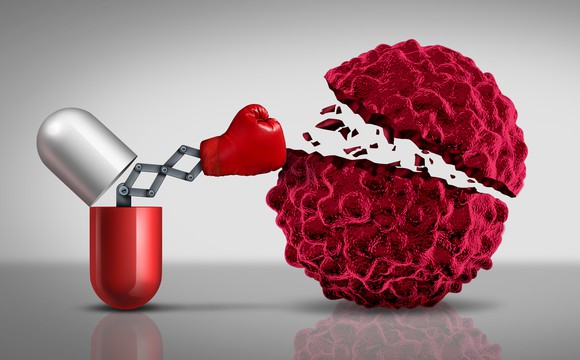This has become the new norm for cancer drugs, and neither consumers nor insurers are happy about it.

NEXT-GENERATION CANCER DRUGS OFFER NEW HOPE TO PATIENTS. IMAGE SOURCE: GETTY IMAGES.
U.S. Food and Drug Administration has been a busy bee of late. Even though the drug development process of taking a molecule from discovery to the pharmacy shelf can take upwards of a decade, the FDA has approved 73 novel drugs since September 2014. Of these 73 new drugs, a whopping 20 of them are targeting cancer.
It's not hard to understand why oncology is such a hot area of research for drug developers. According to the IMS Institute for Healthcare Informatics' annual Global Oncology Trend Report, cancer-drug sales totaled $107 billion in 2015, and they're expected to climb to $150 billion by 2020. Cancer, itself, is a large unmet disease, giving both big and small players an opportunity to make a difference, as well as fund future research with the potential profits of approved drugs.
New cancer drugs are all extremely pricey
But the one factor that really stands out regarding the 20 cancer drugs approved since September 2014 is that they're essentially all extremely expensive for both the consumer and insurance companies. Here are the approximate annual costs of these 20 cancer drugs, listed in chronological order with the most recent approval first.
These 20 Recently Approved Cancer Drugs Essentially Have 1 Thing in Common
This has become the new norm for cancer drugs, and neither consumers nor insurers are happy about it.
Cancer Drug Pill Knocking Out Cancer Cell Getty
NEXT-GENERATION CANCER DRUGS OFFER NEW HOPE TO PATIENTS. IMAGE SOURCE: GETTY IMAGES.
The U.S. Food and Drug Administration has been a busy bee of late. Even though the drug development process of taking a molecule from discovery to the pharmacy shelf can take upwards of a decade, the FDA has approved 73 novel drugs since September 2014. Of these 73 new drugs, a whopping 20 of them are targeting cancer.
It's not hard to understand why oncology is such a hot area of research for drug developers. According to the IMS Institute for Healthcare Informatics' annual Global Oncology Trend Report, cancer-drug sales totaled $107 billion in 2015, and they're expected to climb to $150 billion by 2020. Cancer, itself, is a large unmet disease, giving both big and small players an opportunity to make a difference, as well as fund future research with the potential profits of approved drugs.
New cancer drugs are all extremely pricey
But the one factor that really stands out regarding the 20 cancer drugs approved since September 2014 is that they're essentially all extremely expensive for both the consumer and insurance companies. Here are the approximate annual costs of these 20 cancer drugs, listed in chronological order with the most recent approval first.
Drug
|
Approximate Annual Cost
|
|---|---|
Tecentriq
|
$150,000
|
Venclexta
|
$109,500
|
Alacensa
|
$150,000
|
Empliciti
|
$142,000
|
Portrazza
|
$173,200
|
Ninlaro
|
$104,000
|
Darzalex
|
$135,000
|
Tagrisso
|
$153,000
|
Cotellic (w/Zelboraf)
|
$211,200
|
Yondelis
|
$40,500
|
Lonsurf
|
Insufficient data
|
Odomzo
|
$144,000
|
Unituxin
|
$150,000
|
Farydak
|
$109,800
|
Lenvima
|
$167,300
|
Ibrance
|
$118,200
|
Opdivo
|
$143,000
|
Lynparza
|
Insufficient data
|
Blincyto
|
$178,000
|
Keytruda
|
$150,000
|
TABLE BY AUTHOR. DATA FROM VARIOUS NEWS SOURCES. LONSURF AND LYNPARZA DID NOT HAVE RELIABLE U.S. COST DATA, AND THUS ARE REPRESENTED AS "INSUFFICIENT DATA." .
With the exception of Yondelis, a chemotherapy treatment administered to treat soft tissue sarcomas, there isn't a single cancer drug approved since September 2014 that costs less than $104,000 annually at the wholesale level. Understand that insurers are almost assuredly getting some level of gross-to-net discounts from these drugmakers off wholesale listed prices, and that patients taking these drugs may not be on them for an entire year. Life expectancies and treatment tolerability vary by cancer type and the drug being administered, so in some cases these drug costs may be more palatable than what you see above.
...